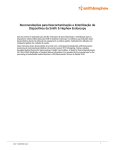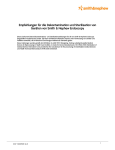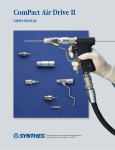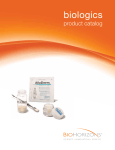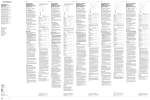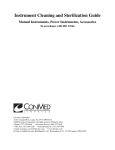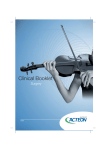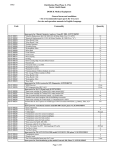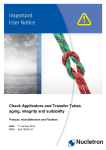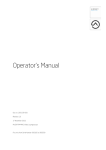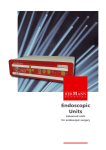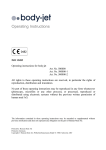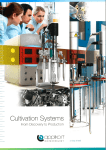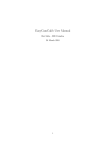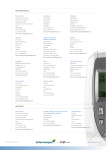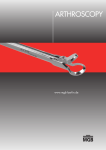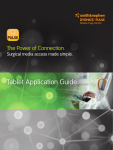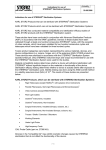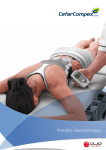Download Recommendations for Decontamination and
Transcript
Recommendations for Decontamination and Sterilization of Smith & Nephew Endoscopy Devices This document was prepared to provide decontamination and sterilization instructions for the medical devices produced by Smith & Nephew Endoscopy. These methods were developed using standard equipment and practices common to global healthcare facilities. These instructions were developed using the guidance given in AAMI TIR 12 (Designing, Testing, Labeling Reusable Medical Devices for Reprocessing in Health Care Facilities: A Guide for Device Manufacturers), ISO 17664:2004 (Sterilization of medical devices-Information to be provided by the manufacturer for the processing of resterilizable medical devices) and Health Technical Memorandum (HTM) 2030. 03/07 10600015 Rev. B General Information for Recommended Disinfection of Reusable Devices Cleaning is the single most important step in preparing a device for reuse. Proper cleaning must be carried out to achieve effective decontamination/sterilization. Thorough cleaning and rinsing are vital to reprocessing reusable medical devices. The purpose of cleaning and rinsing is to remove all adherent visible soil and to reduce the number of particulates, microorganisms, and pyrogens. Also, thorough rinsing is important for removing any residual cleaning agents from the medical devices. The recommended cleaning instructions in this document include both manual and automatic washing/disinfection procedures. While manual cleaning is the most universal method of cleaning, automatic washing may be preferred in some applications. Cleaning Agents/ Equipment Important Information/Recommendations for Use Detergents Enzymatic detergents with a neutral pH range (typically between 6.0 and 8.0) are recommended. Detergents with a pH outside this range (i.e., neodisher® MediClean forte) pH 10.5–10.9 have been approved for use with most devices. Some individual exceptions are noted. Enzymatic detergents aid in the removal of organic soil such as blood. Detergents should be used at the concentration level recommended by the detergent manufacturer. EnzolT, EnzyCARET and Renu-KlenzT (neutral pH enzymatic detergents manufactured by STERIS Corporation) were used in the validation of the cleaning processes for Smith & Nephew Endoscopy devices. Water The quality of water should be considered for use in cleaning reusable devices. Water hardness is a concern because deposits left on medical devices may result in ineffective decontamination. In some cases, distilled water may be recommended in the Instructions for Use for a particular device. Disinfection Solutions Solutions such as glutaraldehyde are sometimes used in healthcare facilities for disinfection of devices. These types of disinfectants have not been validated as sterilants for any Smith & Nephew Endoscopy devices. These solutions should be considered as disinfecting agents only. Ultrasonic Cleaner Ultrasonic cleaners are designed for fine cleaning of medical devices, not for disinfection or sterilization. Ultrasonic cleaning should be used only after gross soil has been removed from the devices. Ultrasonic cleaners are used to remove soil from joints, crevices, lumens, and other difficult-to-access locations. The use of enzymatic detergent in the ultrasonic cleaner is recommended. Ultrasonic cleaners should be monitored routinely to ensure they are working properly. Automatic Washer/ Disinfector Washer/disinfectors are not only used to clean devices, but also to provide intermediate to high-level disinfection with a hot water rinse. Cleaning is dependent on thorough coverage of the devices and the force of the water spray. Therefore, all sections of the device must be accessible for ease of cleaning and penetration of cleaning agents. The automatic washer/disinfector equipment should be operated following the manufacturer’s Instructions for Use. Manual Cleaning Aids/ Instruments General purpose cleaning brushes and low-linting, non-abrasive soft cloths should be used as indicated in device Instructions for Use. Brushes should have a tight fit, but be able to be moved back and forth in the area being cleaned. 03/07 10600015 Rev. B Recommended Cleaning Methods for Reusable Devices Efforts have been made by Smith & Nephew Endoscopy to validate reusable device cleaning methods to current international guidelines. These methods were developed using standard equipment and practices common to healthcare facilities. Other methods of cleaning may be suitable, but must be validated by the user of the device. Warnings These procedures do not apply to single-use devices. Smith & Nephew Endoscopy does not support the reuse of single-use devices. Enzymatic detergent solutions used in ultrasonic cleaners should be changed before they become heavily soiled so that effective cleaning is not inhibited. When cleaning instrument sets, the case and instruments should be treated as separate items. For automatic washing, devices must be cleaned separate from the instrument case/tray. All cleaning should be performed in a manner designed to minimize exposure to blood-borne pathogens. Manual cleaning should be performed with the instrument immersed. It is the responsibility of the user to ensure that the cleaning process, as it is actually performed, achieves the desired result. Limitations of Cleaning Instructions Products requiring more specific cleaning details are supplied with inserts describing recommended cleaning methods. Users should check package inserts (Instructions for Use) to determine if more specific cleaning instructions are recommended for individual devices than those found herein. Where the package insert only describes an alternate cleaning method, it may be used interchangeably with the methods described herein. Point of Use Follow recommended “point of use” practices. These practices should include keeping the devices moist after use to prevent soil from drying, and removing gross soil from surfaces, crevices, hinged/mating surfaces, cannulas, joints, etc. as soon as possible after use. Preparation for Cleaning • PRECAUTION: Products with accessories or parts that are detachable must be disassembled for individual cleaning and then reassembled prior to sterilization. Note: Questions concerning the disassembly of any Smith & Nephew Endoscopy devices should be directed to the Customer Service Department (see Contact Information). • Automatic Washing: Dried-on soil is difficult and sometimes impossible to remove with automatic washing, especially at challenging design feature areas such as joints and crevices. The removal of gross soil from these areas prior to washing in automatic washer equipment is critical for achieving effective cleaning. Instrument Cases/Trays 03/07 10600015 Rev. B Instrument cases/trays are considered reusable devices. Trays should be inspected for visible soil and must be cleaned prior to use. They can be cleaned manually or in an automatic washer using a neutral pH detergent. Device Cleaning Cleaning of medical devices is dependent upon the extent of soiling and product design features. Some Smith & Nephew Endoscopy devices do not have design features that are a challenge to validated cleaning methods, while others do. Therefore, the following cleaning procedures are divided into groups based on these criteria: Devices without challenging design features Devices with challenging design features Examples of Devices Without Challenging Design Features • • • • • • Rasps Osteotomes Knives Sizing Tubes Pins, Wires Obturators, Trocars Examples of Devices With Challenging Design Features Cannulations (Lumens) or Holes • Reusable Cannulas • Cannulated Drills • INTELIJET™ Rotatable Cannulas • Fastenator Anchor Delivery Devices • Hysteroscopes • Direct-View/Videoarthroscopes • DYONICS™ POWER/EP-1™/TRIVEX™ Motor Drive Units Interfaces • T-Handles • Rotary Handles • Quick Release Handles • ACL REDUX™ Devices • Fastenator Anchor Delivery Device Hinged Instruments with Mating Surfaces • ACUFEX™ Hand Instruments such as graspers, scissors, forceps • Suction Punches • Laparoscopic Hand Instruments • Sterilization Trays Instruments with Crevices • Cutting Blocks/Strips • ENDOBUTTON™ Holder Block • GRAFTMASTER™ Boards/Bases • Suture Vice and Tensiometer • Sterilization Trays • TRIVEX™ Illuminators • Camera Heads • Camera Couplers • DYONICS™ Power Drills/Saws • Light Cables 03/07 10600015 Rev. B Manual Cleaning Devices Without Challenging Design Features Note: For more details, refer to product-specific Instructions for Use 1.For devices containing a soak cap, ensure that the soak cap is in place over electrical connectors prior to the start of cleaning. 2. Soak instruments for a minimum of one (1) minute in enzymatic detergent. 3. Use a cleaning brush or cloth to remove visible soil. 4. Rinse thoroughly with warm water. 5. Check the instrument for visible soil. Repeat cleaning if soil is visible. Devices With Challenging Design Features Note: For more details, refer to product-specific Instructions for Use 1.For devices containing a soak cap, ensure that the soak cap is in place over electrical connectors prior to the start of cleaning. 2.For devices containing suction levers or stopcocks, ensure that these features are in the full open position, or disassembled as required by the specific Instructions for Use. 3.Immerse instrument and soak for a minimum of five (5) minutes in enzymatic detergent. 4.Use cleaning brushes to remove additional soil from challenging design features, taking care not to scratch optical surfaces, if present. a.Scrub interfaces several times using a twisting action if possible. If components of the instrument can be retracted or moved, it is necessary to retract or open in order to access and clean these areas. b.Scrub inside cannulas or holes with a tight-fitting brush using a twisting action. The brush should be of an appropriate size to ensure that the full depth of the area is reached. c. Scrub crevices and around hinged/mating surfaces with a brush. d.Scrub each optical surface (if present) with a gauze pad soaked in an enzymatic detergent. 5.If possible, it is highly recommended to sonicate the instrument in its fully open position for a minimum of 15 minutes in ultrasonic cleaning equipment containing warm enzymatic detergent. Note: Some Smith & Nephew Endoscopy devices (e.g., camera heads, couplers and endoscopes) cannot be exposed to ultrasonics. Refer to product-specific Instructions for Use to ensure the device is compatible. 03/07 10600015 Rev. B 6.Rinse thoroughly with warm water, making sure to irrigate the challenging design features. If components of the instrument can be retracted or moved, it is necessary to retract or open for thorough rinsing at these locations. Blind holes should be repeatedly filled and emptied. 7.Scrub each optical surface (if present) with a gauze pad soaked in isopropyl alcohol. Rinse thoroughly with distilled water. 8.Scrub each optical surface (if present) with a gauze pad soaked in acetone. Rinse thoroughly with distilled water. 9. Check instruments for visible soil. Repeat cleaning if soil is visible. Automatic Washing Note: The following devices have not been approved for automatic washing or thermal disinfection: • Camera Heads • TRIVEX™ Illuminators/Motor Drive Units • DYONICS™ Power Drills/Saws • Scopes and Couplers Precleaning Devices Without Challenging Design Features: Precleaning is not required for used devices that do not have dried-on soil. Devices can be placed directly into the automatic washer for cleaning. Devices With Challenging Design Features 1.Immerse in enzymatic detergent and scrub cannulas, mating surfaces, etc. using tight-fitting brushes. Use a twisting action where possible. 2.Sonicate in fully opened position for a minimum of ten (10) minutes in warm enzymatic detergent. 3. Rinse with warm water. Automatic Washing Cycle 1.Load the instruments in the washer such that all design features of the device are accessible to cleaning and such that design features that might retain liquid can drain (hinges should be open and cannulations/holes positioned to drain). 2. Run the automatic wash cycle - minimum cycle parameters: • 5 minute cold prewash • 5 minute enzymatic wash at 43° C minimum temperature • 5 minute detergent wash at 55° C minimum temperature • 1 minute rinse at 45° C minimum temperature 3. Check instruments for visible soil. Repeat cleaning if soil is visible and reinspect. Thermal Disinfection Minimum Cycle Parameters: one (1) minute at 91° C Cleaning Verification 1.After cleaning, visually inspect devices under normal lighting for the removal of visible soil. 2.For difficult-to-view design features, apply 3% hydrogen peroxide (bubbling is evidence of the presence of blood). Note: Rinse instruments thoroughly with warm water following hydrogen peroxide testing. Storage 3. Repeat cleaning if not visibly clean and reinspect. Medical devices that will be stored between cleaning and sterilization should be dried with a low-linting, non-abrasive soft cloth to prevent microbial contamination that could result from wet instruments. Instruments should ALWAYS be thoroughly cleaned prior to storage. 03/07 10600015 Rev. B Recommended Sterilization Instructions The following recommended sterilization methods have been validated to sterility assurance levels (SAL) in compliance with federal and international guidance/standards. Other sterilization cycles may also be suitable, however the validation of cycles not included here is the responsibility of the individual user. Warnings •Reprocessing of implants or other single-use disposable devices that have been soiled is not supported by Smith & Nephew Endoscopy. •Except where specifically noted, gas plasma and hydrogen peroxide are not validated methods for Smith & Nephew Endoscopy devices. •ONLY titanium implants may be sterilized in health care facilities. POLYMER IMPLANTS ARE SOLD STERILE ONLY AND ARE NOT RESTERILIZEABLE. •Package inserts are provided with all implants and other reusable devices to provide instruction for sterilization/resterilization when applicable. •These recommended procedures are intended as a general guide for sterilization of medical devices sold by Smith & Nephew Endoscopy and are not intended as a replacement for the package inserts. •Specific instructions for sterilization listed in package inserts takes precedence over the information listed herein. Instruments (reusable devices) Most reusable devices are sold non-sterile. It is critical to properly clean all reusable devices prior to sterilization. Instrument Cases/Trays It is important that proper cleaning of instrument cases/trays be performed prior to sterilization. Reference the recommended cleaning procedures. Preparation for Sterilization Single-Use Devices Only •Only sterilize non-sterile titanium implants and pins/wires that are indicated for single use. •Prior to sterilization of the device, remove all original packaging and labeling inserts. Place the device in a suitable packaging for the sterilization process, i.e., central supply wrap, autoclave pouches, etc. •Special care should be taken to protect the device from contact with other metal or hard objects that could damage the implant. •Packaging should be inspected for punctures or other damage before and after sterilization. Reusable Devices 03/07 10600015 Rev. B • It is important that adequate cleaning be performed prior to sterilization. •Reusable devices must be placed in a suitable packaging for the sterilization process, i.e., central supply wrap, autoclave pouches, etc. • Separate camera head, scope and coupler prior to sterilization. •Sterilization cases/trays must be wrapped with an approved central supply wrap prior to sterilization. The case/tray by itself does not provide a sterile barrier. • Do not stack sterilization cases/trays in the sterilizer! Recommended Sterilization Parameters High Temperature Prevac Steam • Exposure temperature 132–135° C (270–275° F) • Exposure time 3–4 minutes Flash Prevac Steam • Exposure temperature 132–138° C (270–280° F) • Exposure time 3–4 minutes. UK Steam Cycle • Exposure temperature 134–138° C (273–280° F) • Exposure time 3 minutes (minimum) World Health Organization (WHO) Steam Cycle • Exposure temperature 134–138° C (273–280° F) • Exposure time 18 minutes High Temperature Gravity Steam • Exposure temperature 132–135° C (270–275° F) • Exposure time: – 10 minutes with the EXCEPTION of the following: DYONICS™ Power Drills/Saws, Denervation Probes, and TRUKOR™ Instruments Standard Temperature Gravity Steam • Exposure temperature 121–125° C (250–254° F) • Exposure time: applicable ONLY for instruments noted – 10 minutes (Arthroscopic Cannulas, Obturators, Trocars, including INTELIJET™, Direct-View Scopes, Video Arthroscopes) – 30 minutes (all other devices) 100% Ethylene Oxide Cycle (A) • Exposure temperature 50–60° C (122–140° F) • Exposure time: Applicable ONLY for instruments noted – Arthroscopic Cannulas, Obturators and Trocars are not validated for EO sterilization – 2 hours (Rotary and Quick Release Handles, ACL REDUX™ Devices, Suction Punches, GRAFTMASTER™ Sets in Trays) – 4 hours (All other devices) • EO concentration 580–730 mg/litre • Relative humidity 60–100% • Aeration time: 12 hours 03/07 10600015 Rev. B Recommended Sterilization Parameters (continued) 100% Ethylene Oxide Cycle (B) • • • • • Exposure temperature 50–60° C (122–140° F) Exposure time: 60 minutes EO concentration ~730 mg/litre Relative humidity 35–70% Aeration time: 12 hours 90/10 Ethylene Oxide Cycle • • • • • Exposure temperature 50–60° C (122–140° F) Exposure time: 120 minutes EO concentration ~600 mg/litre Relative humidity 50–70% Aeration time: 12 hours. 100% Ethylene Oxide Cycle (C) • Exposure temperature 50–60° C (122–140° F) • Exposure time: 60 minutes • EO concentration ~883 mg/litre • Relative humidity 30–70% • Aeration time: 12 hours 100% Ethylene Oxide Cycle (D) • Exposure temperature 52–60° C (125–140° F) • Exposure time: 180 minutes • EO concentration ~700–750 mg/litre • Relative humidity 30–70% • Aeration time: 12 hours STERIS System 1® •Sterilize as instructed in the STERIS System 1 User Manual (the standard cycle contains no user variables) STERRAD® 100 •Sterilize as instructed in the STERRAD 100 User Manual (the standard cycle contains no user variables) STERRAD® 100S 03/07 10600015 Rev. B •Sterilize as instructed in the STERRAD 100S User Manual (the standard cycle contains no user variables) Recommended Sterilization Method by Device Type Device Type Approved Sterilization Method(s) Titanium Implants High Temperature Prevac Steam Non-Cannulated Metal Devices Flash Prevac Steam ACUFEX™ Handheld Instruments UK Steam Cycle (graspers, scissors, etc.) WHO Steam Cycle Cannulated Drivers, etc. High Temperature Gravity Steam Laparoscopic Instruments Wires Standard Temperature Gravity Steam with 30 minute exposure Rotary Handles High Temperature Prevac Steam Quick Release Handles Flash Prevac Steam ACL REDUX™ Devices UK Steam Cycle Suction Punches WHO Steam Cycle 100% Ethylene Oxide (Cycle D) with 4 hour exposure High Temperature Gravity Steam Standard Temperature Gravity Steam with 30 minute exposure High Temperature Gravity Steam 100% Ethylene Oxide (Cycle D) with 4 hour exposure GRAFTMASTER™ Sets in Trays High Temperature Prevac Steam Flash Prevac Steam UK Steam Cycle WHO Steam Cycle High Temperature Gravity Steam Standard Temperature Gravity Steam with 30 minute exposure 100% Ethylene Oxide (Cycle A) with 2 hour exposure Arthroscopic Cannulas High Temperature Prevac Steam Obturators Flash Prevac Steam Trocars, including INTELIJET™ UK Steam Cycle WHO Steam Cycle High Temperature Gravity Steam Standard Temperature Gravity Steam with 10 minute exposure Non-Autoclavable Scopes, including: STERIS SYSTEM 1® 10 • Direct View STERRAD® 100S • Videoarthroscopes Ethylene Oxide (Cycle B) 03/07 10600015 Rev. B Recommended Sterilization Method by Device Type (continued) Device Type Non-Autoclavable Camera Couplers Approved Sterilization Method(s) STERIS SYSTEM 1® STERRAD® 100S Ethylene Oxide (Cycle B) with 120 minute exposure Autoclavable Scopes, including: • Direct-View • Laparoscopes • Videoarthroscopes High Temperature Prevac Steam with 4 minute exposure WHO Steam Cycle High Temperature Gravity Steam • Microlaparoscopes Autoclavable Camera Couplers TRIVEX™ Illuminators Motor Drive Units Operative Hysteroscopes Multimode Scopes and Couplers Hysteroscopes High Temperature Prevac Steam with 4 minute exposure WHO Steam Cycle High Temperature Gravity Steam 100% Ethylene Oxide (Cycle B) STERIS SYSTEM 1® STERRAD® 100S STERRAD 100 (Hysteroscope only) DYONICS™ Power Drills/Saws High Temperature Prevac Steam with 4 minute exposure and 8 minute dry time WHO Steam Cycle High Temperature Gravity Steam with 35 minute exposure and 8 minute dry time Fiber Light Guides High Temperature Prevac Steam with 4 minute exposure WHO Steam Cycle High Temperature Gravity Steam STERRAD 100S 100% Ethylene Oxide (Cycle B) Plastic Camera Heads STERIS SYSTEM 1 STERRAD 100/STERRAD 100S 100% Ethylene Oxide (Cycle B) Metal Camera Heads 03/07 10600015 Rev. B 100% Ethylene Oxide (Cycle C) 11 Recommended Sterilization Method by Device Type (continued) Device Type EP-1™/DYONICS™ Power Approved Sterilization Method(s) High Temperature Prevac Steam with 4 minute exposure WHO Steam Cycle High Temperature Gravity Steam Operative Laparoscope 90/10 Ethylene Oxide Non-Autoclavable Microlaparoscope 100% Ethylene Oxide (Cycle B) Denervation Probes High Temperature Prevac Steam with 4 minute exposure and 20 minute dry time High Temperature Gravity Steam with 30 minute exposure and 20 minute dry time VULCAN™ Extension Cables High Temperature Prevac Steam with 4 minute exposure High Temperature Gravity Steam with 10 minute exposure ELECTROTHERMAL™ 20S Spine System High Temperature Prevac Steam with 6 minute exposure Extension Cables High Temperature Gravity Steam with 10 minute exposure Tenet Spider Limb Positioner/T-MAX Shoulder Positioner Accessories High Temperature Prevac Steam with 3 minute exposure High Temperature Gravity Steam with 10 minute exposure TRUKOR™ Instruments High Temperature Prevac Steam with 12 minute exposure and 20 minute dry time, wrapped with 14 minute exposure and 20 minute dry time, unwrapped High Temperature Gravity Steam with 30 minute exposure and 20 minute dry time, wrapped in muslin Important Sterilization Notes Smith & Nephew Endoscopy, the Association of Operating Room Nurses (AORN), and the National Center for Infectious Diseases (NCID) in Atlanta (USA) do not recommend the use of flash steam sterilization on implants. Contact Information Smith & Nephew Customer Service: +1-800-343-5717 or +1-978-749-1000 in the U.S., or contact your authorized Smith & Nephew representative. ™Trademarks of Smith & Nephew. Certain marks registered U.S. Patent and Trademark Office. All other trademarks acknowledged. Endoscopy Smith & Nephew, Inc. Andover, MA 01810 USA 12 www.smith-nephew.com +1 978 749 1000 +1 978 749 1108 Fax +1 800 343 5717 U.S. Customer Service ©2005, 2007 Smith & Nephew, Inc. All rights reserved. 03/07 10600015 Rev. B












